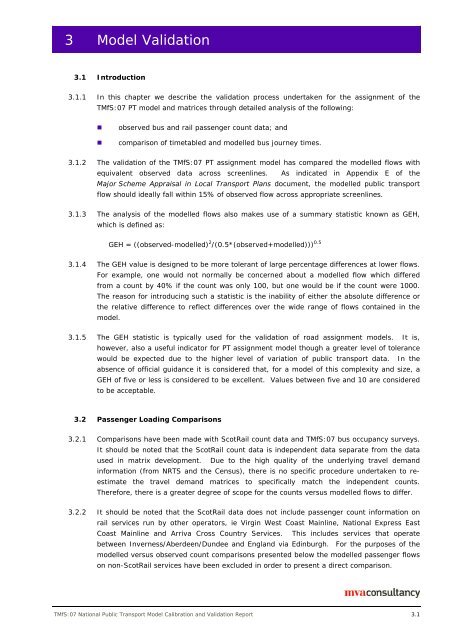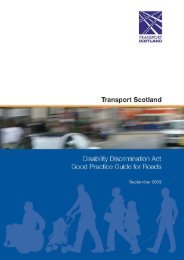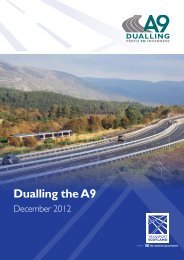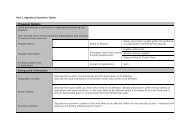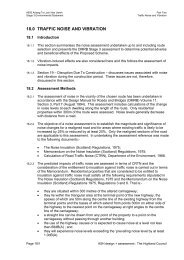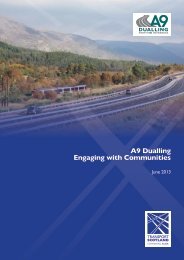Public Transport Model Calibration and Validation Report
Public Transport Model Calibration and Validation Report
Public Transport Model Calibration and Validation Report
Create successful ePaper yourself
Turn your PDF publications into a flip-book with our unique Google optimized e-Paper software.
3 <strong>Model</strong> <strong>Validation</strong><br />
3.1 Introduction<br />
3.1.1 In this chapter we describe the validation process undertaken for the assignment of the<br />
TMfS:07 PT model <strong>and</strong> matrices through detailed analysis of the following:<br />
• observed bus <strong>and</strong> rail passenger count data; <strong>and</strong><br />
• comparison of timetabled <strong>and</strong> modelled bus journey times.<br />
3.1.2 The validation of the TMfS:07 PT assignment model has compared the modelled flows with<br />
equivalent observed data across screenlines. As indicated in Appendix E of the<br />
Major Scheme Appraisal in Local <strong>Transport</strong> Plans document, the modelled public transport<br />
flow should ideally fall within 15% of observed flow across appropriate screenlines.<br />
3.1.3 The analysis of the modelled flows also makes use of a summary statistic known as GEH,<br />
which is defined as:<br />
GEH = ((observed-modelled) 2 /(0.5*(observed+modelled))) 0.5<br />
3.1.4 The GEH value is designed to be more tolerant of large percentage differences at lower flows.<br />
For example, one would not normally be concerned about a modelled flow which differed<br />
from a count by 40% if the count was only 100, but one would be if the count were 1000.<br />
The reason for introducing such a statistic is the inability of either the absolute difference or<br />
the relative difference to reflect differences over the wide range of flows contained in the<br />
model.<br />
3.1.5 The GEH statistic is typically used for the validation of road assignment models. It is,<br />
however, also a useful indicator for PT assignment model though a greater level of tolerance<br />
would be expected due to the higher level of variation of public transport data. In the<br />
absence of official guidance it is considered that, for a model of this complexity <strong>and</strong> size, a<br />
GEH of five or less is considered to be excellent. Values between five <strong>and</strong> 10 are considered<br />
to be acceptable.<br />
3.2 Passenger Loading Comparisons<br />
3.2.1 Comparisons have been made with ScotRail count data <strong>and</strong> TMfS:07 bus occupancy surveys.<br />
It should be noted that the ScotRail count data is independent data separate from the data<br />
used in matrix development. Due to the high quality of the underlying travel dem<strong>and</strong><br />
information (from NRTS <strong>and</strong> the Census), there is no specific procedure undertaken to reestimate<br />
the travel dem<strong>and</strong> matrices to specifically match the independent counts.<br />
Therefore, there is a greater degree of scope for the counts versus modelled flows to differ.<br />
3.2.2 It should be noted that the ScotRail data does not include passenger count information on<br />
rail services run by other operators, ie Virgin West Coast Mainline, National Express East<br />
Coast Mainline <strong>and</strong> Arriva Cross Country Services. This includes services that operate<br />
between Inverness/Aberdeen/Dundee <strong>and</strong> Engl<strong>and</strong> via Edinburgh. For the purposes of the<br />
modelled versus observed count comparisons presented below the modelled passenger flows<br />
on non-ScotRail services have been excluded in order to present a direct comparison.<br />
TMfS:07 National <strong>Public</strong> <strong>Transport</strong> <strong>Model</strong> <strong>Calibration</strong> <strong>and</strong> <strong>Validation</strong> <strong>Report</strong> 3.1


